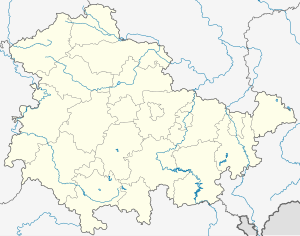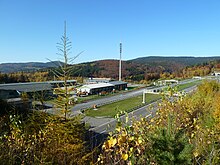Rennsteig tunnel
|
|
||
|---|---|---|
| use | Road tunnel | |
| traffic connection | A 71 | |
| length | 7916 m (west tube) 7878 m (east tube) |
|
| Number of tubes | 2 | |
| construction | ||
| building-costs | € 200 million (current purchasing power approx. € 251.7 million) |
|
| start of building | June 26, 1998 | |
| business | ||
| release | July 7, 2003 | |
| location | ||
|
|
||
| Coordinates | ||
| East portal | 50 ° 42 ′ 45 " N , 10 ° 46 ′ 36" E | |
| West portal | 50 ° 40 ′ 10 " N , 10 ° 41 ′ 21" E | |
The Rennsteig Tunnel , officially known as the Rennsteig Tunnel , is the longest road tunnel in Germany at 7,916 meters and, after the Gran Sasso Tunnel , the Plabutsch Tunnel and the Seelisberg Tunnel , the fourth longest two-tube road tunnel in Europe. As part of the A 71 Erfurt - Schweinfurt motorway , between the Gräfenroda and Oberhof junctions (in Zella-Mehlis ), it crosses the ridge of the Thuringian Forest with the Rennsteig ridge trail . It is also known as the Christiane Tunnel after its godmother Christiane Herzog . The Hochwald and Berg Bock tunnels follow directly to the south, and the Alte Burg tunnel to the north .
history
The Rennsteig Tunnel is part of the German Unity Transport Project No. 16, the expansion of the federal highways 71 and 73. In the original regional planning procedure , a chain of three tunnels was planned. Additional variants were developed and examined as part of the design planning. From this the tunnel in its present form was finally developed.
The groundbreaking ceremony took place on June 26, 1998. The opening took place on July 5, 2003 by the then Federal Chancellor Gerhard Schröder , and the opening for traffic two days later. The construction time was 57 months with construction costs of around 200 million euros, which would correspond to around 251.7 million euros based on today's purchasing power.
construction
The western tube has a length of 7,916 meters, the length of the eastern tube is 7,878 meters. The distance between the tubes is about 25 meters. Each tube has a clearance width of 9.5 meters and a clearance height of 4.5 meters. They have two 3.5 meter wide lanes, shoulder strips 0.25 meters, emergency walkways one meter wide on both sides and twelve breakdown bays. The tubes are connected to one another by 25 cross tunnels at intervals of 300 meters. Due to the length of the pipes, there is an air exchange center for ventilation in the intermediate valleys Kehltal, 3,041 meters from the north portal at kilometer 118, and Floßgraben, 2,460 meters from the south portal at kilometer 120. This means that there are three ventilation sections of approximately the same length for longitudinal ventilation. The tunnel air is extracted in the air exchange centers by means of four axial fans and blown out via exhaust air chimneys that protrude up to 20 meters above the site. The fresh air is sucked in in the ventilation centers via supply air tunnels and blown in by four axial fans. Longitudinal ventilation is provided by jet fans with 28 units per tube.
The maximum overlap of the tunnel in the mountain, i.e. the vertical distance between the tunnel and the open area, is 205 meters. 1.35 million cubic meters of excavated material accumulated and was used in the subsequent sections of the route. The A 71 reaches its highest point in the middle of the tunnel at 670 m above sea level. NHN . The Rennsteig tunnel crosses the Brandleitetunnel ( railway tunnel ) near the Oberhof train station . There is only about 6 to 7 meters of rock between the two.
The tunnel vault consists of a shotcrete outer shell , depending on the mountain conditions between 5 centimeters (unreinforced) and 25 centimeters (reinforced) thick, a seal made of single-layer 2 millimeter thick plastic sheeting and a 30 to 35 centimeter thick reinforced reinforced concrete outer shell. As a rule, as geologically possible, an open vault cross-section without a base was installed. The gravel required for the production of the concrete came from a gravel works near Sprotta and was delivered to Zella-Mehlis in block trains .
safety
According to a test by the ADAC in 2004, the Rennsteig tunnel is the safest of all the tunnels tested in Europe. For example, every 150 meters there are closed emergency cabins with a camera and hand-held fire extinguishers, every 300 meters the cross tunnels with fire protection doors and every 600 meters at the breakdown bays in the cross tunnels, there is an additional possibility for emergency vehicles to pass between the tunnel tubes. In addition, the supply air tunnels of the air exchange centers can be used as access for rescue vehicles. The power supply in an emergency is ensured by a battery system. The tunnel is closed for the transport of dangerous goods ( tunnel restriction code E). A new system against wrong-way drivers has been tested in a model test since October 2016. Sensors monitor the direction of travel when entering the tunnel.
Specialty
In the tunnel there is a speed limit of usually 80 km / h. There are two measuring points in each direction of travel (fourth breakdown bay at km 117 and ninth breakdown bay at km 120) to monitor the speed of both lanes. They work with piezo sensor fields embedded in the roadway and use infrared light for the evidence photo , which the driver does not perceive but which is sufficiently reflected to show the driver and vehicle (so-called black flash technology ). This is to prevent the "flashed" driver from being frightened and causing an accident. The data are automatically transmitted via data line to the central fines office of the Thuringian police in Artern . The incoming and outgoing sections of the route are also peppered with more modern star boxes , which are not immediately recognized as such.
literature
- Federal Ministry of Transport, Building and Housing: Bridges and tunnels on federal highways 2004. Documentation. German Federal Publishing House, Berlin. ISBN 3-935064-28-4
Web links
Individual evidence
- ^ Gundolf Denzer, Reinhold Maidl: Rennstein tunnel - longest motorway tunnel in Germany . In: Tunnel technology for future tasks in Europe . Balekma-Verlag, Rotterdam 1999, ISBN 90-5809-051-5 , pp. 97-106.
- ^ Bahn-Express: Heinrich Niemeier GmbH & Co. KG, Sprotta gravel works, 04838 Sprotta near Eilenburg
- ↑ heise online: New system warns of wrong-way drivers in the motorway tunnel. In: heise online. Retrieved October 24, 2016 .





